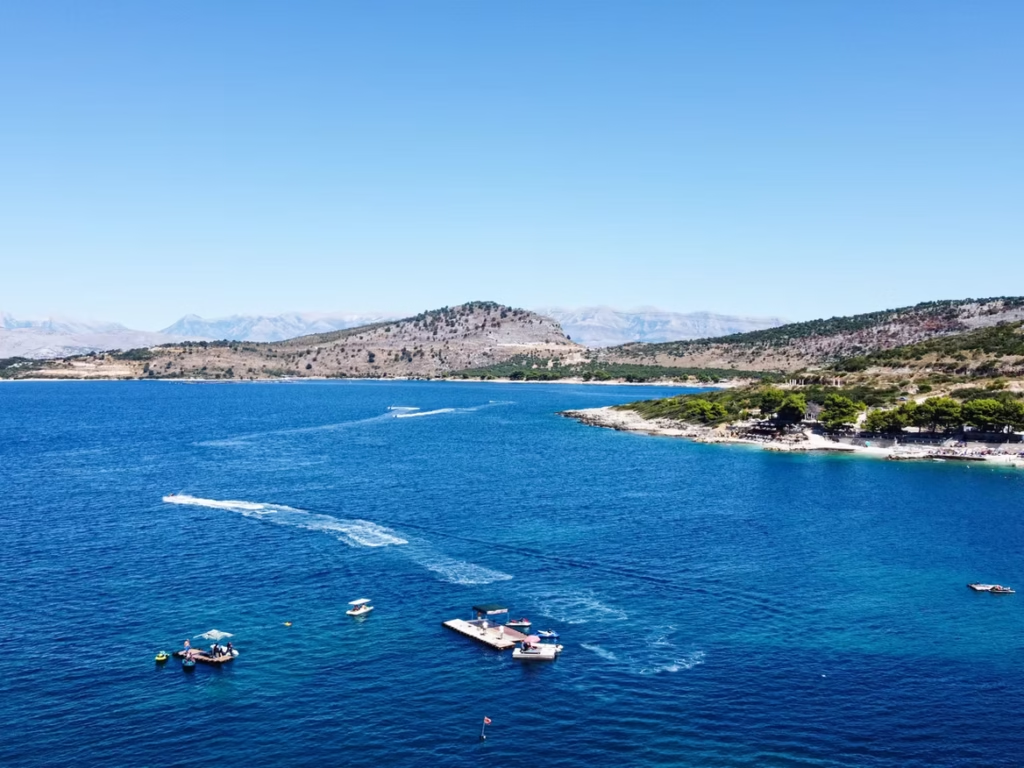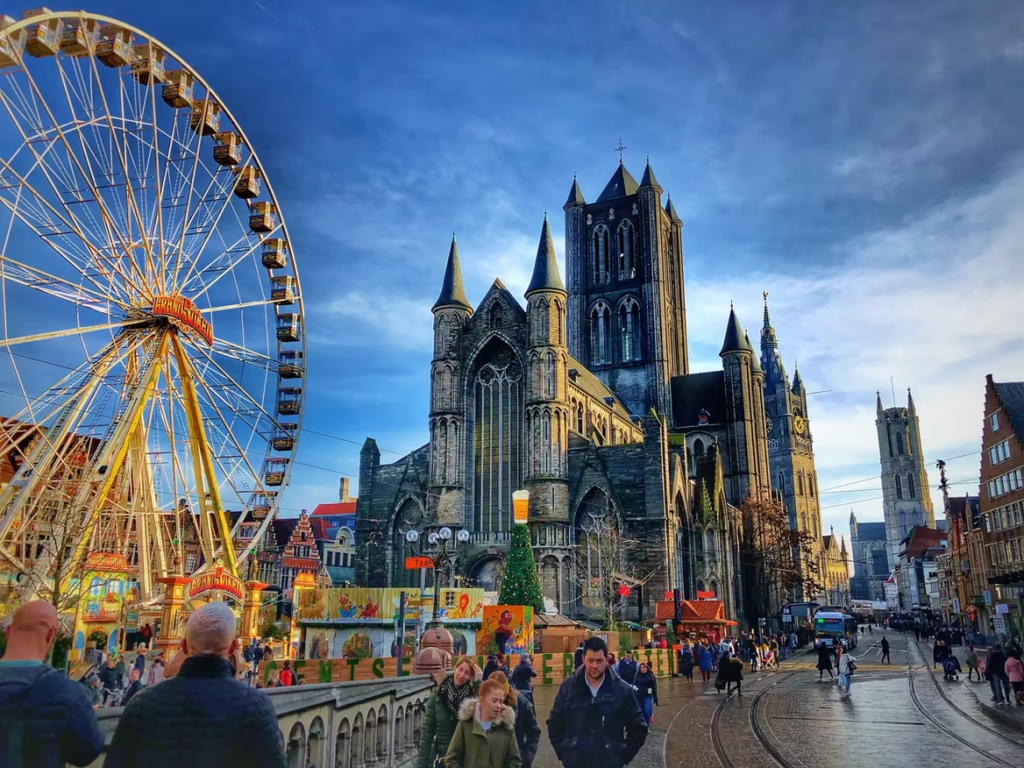Albania’s Albanian Riviera: Sun, Sea, and Untouched Beauty

Tucked away along the Adriatic Sea, you’ll find a hidden holiday gem – the Albanian Riviera. Situated away from the tourist hordes, this sun-soaked coastline entices with aquamarine waters, pristine beaches stretching as far as the eye can see, and lovely limestone cliffs plunging into the sea. Sip espresso at beachside cafes under 150-year-old olive trees, swim among the caves and coves, and hike trails that wind past sleepy villages seemingly untouched by time. That’s just a part of what this little-known slice of Mediterranean paradise offers you. Serene beauty of a Mediterranean Beach (Photo by Bleron on Unsplash) Here is how to experience the pristine glory of Albanian Riviera- 1. Gjipe Beach Aerial view of a crowded beach alongside blue waters (Photo by Renaldo on Unsplash) The word “Gjipe” is derived from the Albanian word for “peace”. As its name suggests, arrive early in the morning to experience Gjipe’s tranquility all to yourself. Nestled at the end of a steep cliffside trail, Gjipe Beach is a hidden gem along the Albanian Riviera. With vistas that look airbrushed and serenity unmatched by larger beaches, Gjipe offers an unspoiled Mediterranean escape. Its remoteness provides a calming reprieve from modern life’s busyness. 2. Ancient Dhermi Huge mountains of Dhermi stretched across (Photo by Sara on Unsplash) In Dhermi, you can uncover ancient ruins and natural beauty in just one charming destination. The most taken route is to hike to the 6th century Monastery of St. Theodore and 4th century BC fortresses for insights into medieval history amidst mountain-top views. Afterwards, descend to Dhermi’s pristine beach, renowned as one of Albania’s most beautiful, for a scenic Mediterranean escape. 3. Drymades Stone ruins of an ancient Greek amphitheater (Photo by Daria on Unsplash) When the sun goes down, Drymades Beach comes alive with lively beach parties, bonfires, and all-night dance clubs. Sip local raki cocktails, sway to modern and folk music under the stars, and meet fellow travelers late into the evening. This sandy shoreline transforms into the Riviera’s most vibrant nightlife destination. 4. Ksamil Islands Top-down view of Ksamil Islands with surrounding emerald green ocean (Photo by Altin on Unsplash) Off the coast of Sarandë lies the untouched beauty of Ksamil Islands, a small archipelago with three main islands – St. Nicholas, Basta, and Ksamil – connected by picturesque footbridges. The Ksamil Islands offer a perfect blend of nature, relaxation, delicious dining, and vibrant nightlife, while retaining a peaceful, remote island feel. This island paradise often remains unexplored and unknown by the tourists making it one of the most underrated destinations on the Riviera. So don’t you rather miss it out! 5. Llogara Pass Aerial view of roads stretching across miles of a green terrain (Photo by Elion on Unsplash) Llogara Pass, reaching 1,043 meters above the Albanian Riviera, offers spectacular views of the coastline and Ionian Sea. As you drive the scenic mountain road, you can stop at lookouts to see beaches unfolding below. One fun activity is to hike the fragrant pine forests and watch for golden eagles overhead. The Llogara mountain pass makes for a rejuvenating pitstop on this Albanian roadtrip. At last, there is also the Llogara National Park nearby which is rich in biodiversity having over 1,000 plant species and roaming wild horses.
Belgium’s Artistic Marvels: Exploring the Flemish Masters and Beyond

In the very heart of Western Europe rest a small but mighty land – Belgium. Though often overlooked on the crowded European map, this plucky country holds an embarrassment of artistic riches within its compact borders. Belgium is a country where the medieval melds seamlessly with the modern. Centuries-old cathedrals and guild houses brush up against contemporary art museums and sleek cafés. This fusion creates an energetic artistic spirit that permeates every city and town. An eclectic aesthetic where old and new are not only embraced, but celebrated. From the vibrant whirl of brushstrokes by Baroque masters to the soaring spires of Gothic grandeur, Belgium offers a bonanza of visual splendor awaiting discovery. Once you arrive here, one thing becomes clear – you don’t have to be big to make a mammoth artistic impact. Sometimes, the greatest creative wonders come in small packages. And this is what this small euro- nation proves this magnificently. A beautiful view of a Belgian city (Source: Unsplash) Now, sit back and relax while we take you across the top attractions in the country- Brussels A street full of people in Brussels (Source: Unsplash) Brussels remains one of Europe’s most enticing capitals for art and architecture devotees. The city brings Belgium’s finest structural designs together, from medieval guildhalls to Art Nouveau façades. The Grand Place exemplifies Brussels’ aesthetic appeal with Gothic towers and intricate baroque details adorning its historic central square. In Brussels you can stroll through ornate Art Nouveau neighborhoods to admire Victor Horta’s UNESCO-protected houses, including the magnificent Stoclet Palace. For an immersive overview, the CIVA Centre’s exhibits masterfully display eight centuries of Brussels’ architectural evolution. As a pilgrimage point for Art Nouveau, the city’s mansions, churches, and commercial buildings transform Brussels into a living museum of Belgian craftsmanship and style. Places to visit- Grand Place, Art Nouveau Neighborhoods, Victor Horta Houses, CIVA Centre Bruges Steep Sloped houses across a river in Bruges (Source: Unsplash) Romantic canals and medieval charm establish Bruges as one of Europe’s most picturesque art cities. Bruges brings the legacy of Belgian art to life with architecture spanning eight centuries. You can visit the egg-shaped Lake of Love for stunning views of the 13th century belfry towering over august buildings or the Groeningemuseum where 15th century Flemish Primitives take center stage, including Jan van Eyck’s “Madonna with Canon van der Paele.” Wander around beetling cobblestone lanes and discover almshouses, patrician residences, and hidden churches adorned with works by Bruges’ Flemish masters. For a quintessential Bruges experience, take a moonlit canal boat ride and enjoy the city’s twinkling architectural marvels, shaped by generations of artists’ brushstrokes. Places to visit- Lake of Love, Belfry Tower, Groeningemuseum Ghent A cathedral in Ghent (Source: Unsplash) With its medieval towers, guildhalls, and patrician mansions reflected in winding canals, Ghent encapsulates the splendor of historic Flemish cities. As one of the largest canal metropolises, Ghent intertwines art and architecture seamlessly. St. Bravo’s Cathedral safeguards the Ghent Altarpiece, featuring the Adoration of the Mystic Lamb, Jan van Eyck’s pioneering 15th century masterwork. Bask in the grandeur of Graslei’s guild houses along the Leie River or venture to the 1460 Belfry and its bell tower views rising above a labyrinth of architectural marvels below, Ghent is for you. From Romanesque to Renaissance to Gothic revival styles, the city exemplifies Belgium’s finest architectural achievements and the art it has inspired for centuries. Place to visit- St. Bravo’s Cathedral, Graslei, Belfry of Ghent, Gravensteen Castle Antwerp Aerial View of a huge building across a river (Source: Unsplash) As the center of baroque style, Antwerp indulges art lovers with Rubens’ lavish paintings around every corner. The ornate guildhouses and step-gabled warehouses lining the Scheldt River reflect the prospering port’s 16th century Golden Age. Make a pilgrimage to the Rubenshuis, the iconic painter’s home and studio, to view his epic works firsthand and lose yourself within Antwerp Cathedral, whose towering Gothic spire dominates the skyline, while interiors house art-adorned chapels and the impressive Raising of the Cross triptych. As the day winds down, join locals at a lively cafe along Grote Markt square, Antwerp’s radiant centerpiece, and toast to the city’s artistic heritage lasting through the centuries. Places to visit– Rubenshuis, Antwerp Cathedral, Grote Markt, Plantin-Moretus Museum Leuven Roadside view of a street in Leuven (Source: Unsplash) With its soaring late Gothic St. Peter’s Church rising above ornate Renaissance facades, Leuven reflects the rich artistic heritage of central Belgium. As the capital of the Brabant province, Leuven cultivated influential early Flemish painters like Rogier van der Weyden. Wander the historic center and encounter stately 15th century architecture, including elaborately carved medieval halls lining the Town Hall. When in Leuven make sure to visit the M Museum Leuven, home to the world’s most comprehensive collection of early Netherlandish masterpieces, including rare works by Robert Campin and Jan van Eyck. After admiring the city’s architectural gems, relax at a lively outdoor café on the Oude Markt, a square bustling with university culture and legacy. Leuven provides the perfect blend of medieval charm, Renaissance beauty, and lively modern energy. Places to visit– St. Peter’s Church, Leuven Town Hall, Groot Begijnhof, Park Abbey Mechelen Windy night on the streets of Mechelen (Source: Unsplash) Mechelen is a hidden gem overflowing with architectural splendor. While smaller than Bruges or Ghent, Belgium’s capital of culture punches above its weight class with artistic treasures. Gothic spires peek above candy-colored houses along tree-lined canals. The monumental City Hall lords over the central square, beckoning visitors inside to see its lavish interior and paintings. St. Rumbold’s soaring cathedral towers above all, its 556-foot spire climbing to the heavens. As day fades to night, witness Mechelen’s buildings glow under spotlights while strolling canal-side and listening to carillons ring out from church towers.

